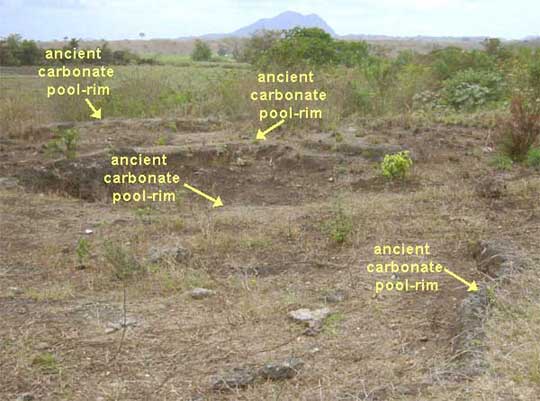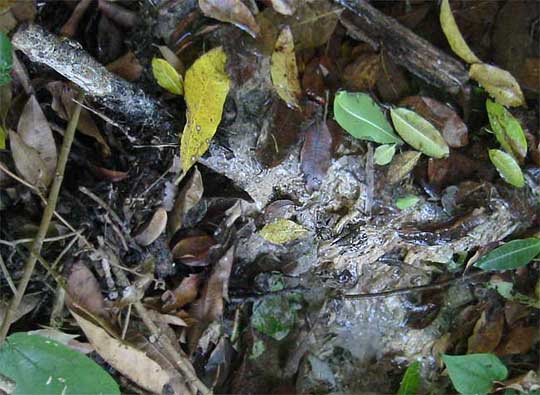Excerpts from Jim Conrad's
Naturalist Newsletter
from the March 24, 2008 Newsletter written in the community of 28 de Junio, in the Central Valley 8 kms west of Pujiltic, elev. ~700m (2300ft), ~N16.331°, ~W92.472°; southeastern Chiapas state, MÉXICO
OLD NATURAL TERRACES
One of my first pictures from here showed a little stream cascading very prettily over a series of natural, carbonate pool-rims. That image still sits at www.backyardnature.net/n/08/080204cc.jpg.
You may also remember the pictures of a variety of fossils found in rocks right outside my door, online at www.backyardnature.net/chiapas/rocks.htm.
I've kept looking at fossils and cogitating about pool-rims until now I've figured out something interesting: The whole quarter-mile-wide level area occupied by the community of 28 de Junio is a natural terrace held in place by a series of many, old, more or less parallel-running carbonate pool-rims. This fact dawned on me when the brushy slope below us was burned. A picture of several barely emergent carbonate pool-rims exposed by the burning can be seen below:

Except for their much greater size, those carbonate pool-rims are just like those being formed today at the little stream in the first picture. Moreover, today the fossilization process is still going on, as shown below:

Above you can see where a tree limb has fallen across a small stream, with leaves lodging behind the limb creating a small, temporary dam. At the picture's lower right, gray, carbonate-rich muck is gathering on vegetative material. A close-up of the mucky part is shown below:

Inside the gray, worm-shaped things in that picture, sometimes you find white, slender tree-roots, sometimes still-green plant stems or leaf petioles, and sometimes nothing. The wormy structures look soft and squishy but they're hard and brittle. When a mass of such stuck-together gunk dries out it becomes fossil-rich rock such as that shown in the second and third pictures at the second link above.
From all this I conclude that in the past a lot more water ran through our area than now. I suspect that it was because of greater rainfall in the past. I asked Don Bartolomé if he could tell me anything about past floods or heavy rains here.
"Back when all this was covered with a forest full of deer and tepescuintles (piglike rodents) and before sugarcane came in the valley," he said, "each July my grandparents would move all their firewood inside. They knew that sometimes during the next two months it'd rain hard day and night and the firewood would never dry out if left outside. Nowadays the only time we get rains like that is when hurricanes come."